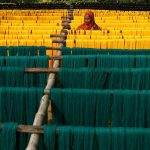You’ll find jute fabric costs in 2024 reflect raw material prices affected by weather and government policies in top producers like India and Bangladesh. Processing expenses, such as labor and energy, add to the price, along with transportation fees linked to distance and fuel. Demand for eco-friendly materials is steady, pushing costs higher, while regional factors and export duties cause price variations. Keep exploring to uncover tips for sourcing jute fabric more cost-effectively.
Table of Contents
Key Takeaways
- Raw jute prices in 2024 are influenced by weather, government policies, input costs, and currency fluctuations in major producing countries.
- Processing costs include cleaning, spinning, weaving, skilled labor, energy, and eco-friendly treatment expenses, impacting final fabric prices.
- Transportation expenses depend on distance, fuel prices, shipment weight, customs duties, and delivery speed, affecting overall jute fabric cost.
- Rising global demand for eco-friendly materials and supply constraints from weather unpredictability are driving up jute prices in 2024.
- Regional price variations occur due to local production costs, labor rates, weaving quality, and export tariffs in major jute-producing countries.
Factors Influencing Raw Jute Prices in 2024
Although global demand plays a crucial role, several key factors directly influence raw jute prices in 2024.
You’ll find that weather conditions in major producing countries like India and Bangladesh considerably affect crop yields. Unexpected heavy rains or droughts can reduce supply, pushing prices up.
Additionally, government policies such as export restrictions or subsidies impact availability and cost.
Transportation infrastructure also matters—if logistics aren’t efficient, costs rise, and so do prices.
Don’t overlook currency fluctuations; a weaker local currency can make jute more expensive internationally.
Finally, input costs like seeds, fertilizers, and labor affect farmers’ expenses, which trickle down to the market price.
Impact of Processing and Manufacturing Costs
Raw jute prices set the stage, but processing and manufacturing costs have a big say in the final price of jute fabric.
Once you source raw jute, you’ll need to factor in cleaning, spinning, and weaving expenses. These steps require skilled labor and specialized machinery, which add to your costs.
Energy consumption during processing can also fluctuate, affecting your budget. Additionally, quality control measures guarantee the fabric meets standards but increase operational costs.
If you opt for eco-friendly dyes or treatments, expect a higher price tag due to more expensive materials and processes.
Finally, wastage during manufacturing impacts your overall cost efficiency.
Understanding these components helps you grasp why jute fabric prices can vary considerably beyond just raw material costs.
Transportation and Logistics Expenses
You’ll find that shipping costs depend on factors like distance, mode of transport, and fuel prices.
These expenses can quickly add up and affect the overall price of jute fabric.
Plus, longer delivery times might increase storage fees or delay your projects.
Shipping Cost Factors
Because transportation and logistics play a crucial role in delivering jute fabric to your destination, understanding the factors that impact shipping costs is essential.
Your shipping expenses depend on the distance between the supplier and your location, as longer routes naturally increase fuel and labor costs. The mode of transport—whether by sea, air, or land—also affects pricing; air freight is faster but pricier, while sea freight is more economical for bulk orders.
Additionally, the weight and volume of your shipment influence costs, as heavier or larger packages require more space and energy to move. Customs duties, handling fees, and insurance can add to your total shipping bill.
Delivery Time Impact
Understanding the factors that influence shipping costs naturally leads to contemplating how delivery time affects your transportation and logistics expenses.
When you opt for faster delivery, you usually pay more because expedited shipping requires priority handling and quicker routes. On the other hand, standard or economy shipping takes longer but costs less, which can be a smart choice if you’re not pressed for time.
Keep in mind that delays or unpredictable transit times can add indirect costs, like storage fees or missed deadlines. Balancing how quickly you need the jute fabric against your budget helps you make smarter logistics decisions.
Market Demand and Supply Trends
Fluctuations in demand and supply greatly influence the jute fabric market in 2024. You’ll notice that rising eco-friendly trends have boosted demand, pushing prices up as more businesses seek sustainable materials.
However, supply constraints, caused by unpredictable weather and limited cultivation areas, have tightened availability. When supply dips but demand remains strong, you’ll see costs increase.
Unpredictable weather and limited cultivation tighten jute supply, pushing costs up when demand stays high.
Conversely, if farmers ramp up production or new processing technologies improve output, supply rises, helping stabilize or reduce prices.
Keep in mind, global shifts toward green packaging and textiles are steadily increasing demand, so you might face higher costs if supply can’t keep pace.
Staying informed about these trends helps you anticipate price changes and plan purchases wisely throughout the year.
Regional Price Variations and Export Considerations
You’ll notice jute fabric prices vary considerably depending on the region due to local production costs and demand.
When exporting, you’ve got to factor in tariffs and additional fees that can impact the final price.
Understanding these differences helps you make smarter purchasing and shipping decisions.
Price Differences by Region
Because jute fabric production centers vary widely, you’ll notice significant price differences by region. In major producers like Bangladesh and India, costs tend to be lower due to abundant raw materials and established manufacturing infrastructure.
However, in regions where jute is less common, such as Europe or North America, prices rise because of higher labor costs and limited local supply.
Additionally, quality and weaving techniques differ by region, influencing price. When sourcing jute fabric, consider these regional factors carefully, as they’ll impact your overall budget.
Understanding where the fabric comes from helps you negotiate better deals and choose suppliers that match your quality and cost expectations, ensuring you get the best value for your purchase without compromising on standards.
Export Tariffs and Fees
When importing jute fabric, export tariffs and fees play a crucial role in determining the final cost. You’ll find that countries like India and Bangladesh, major jute producers, have specific export duties that can affect pricing. These tariffs vary depending on trade agreements and local regulations, so it’s important to check the current rates.
Additionally, customs clearance fees and documentation charges add to your expenses. Don’t forget that import duties in your country also impact the total cost, sometimes considerably.
To keep costs manageable, you should factor in these export-related fees early in your budgeting and consider sourcing from regions with favorable trade terms. Staying informed helps you avoid unexpected charges and guarantees accurate cost forecasting for your jute fabric purchase.
Tips for Cost-Effective Jute Fabric Procurement
Although jute fabric prices can fluctuate, you can secure better deals by planning your purchases strategically and building strong relationships with suppliers.
Start by forecasting your needs accurately to avoid last-minute buys that cost more. Consider buying in bulk to benefit from volume discounts, but balance this with your storage capacity.
Don’t hesitate to negotiate terms and ask for price breaks or flexible payment options. Research multiple suppliers to compare prices and quality, guaranteeing you get the best value.
Also, stay updated on market trends and seasonal demand to time your purchases when prices dip.
Finally, establish clear communication channels with your suppliers to avoid misunderstandings and guarantee timely deliveries, which can save you from costly delays or rush fees.
Frequently Asked Questions
How Durable Is Jute Fabric Compared to Other Natural Fibers?
You’ll find jute fabric quite durable but less so than hemp or linen. It’s strong for its weight, but it can wear down faster with heavy use or moisture exposure, so handle it with some care.
Can Jute Fabric Be Dyed Easily Without Damaging the Fibers?
Imagine you’re dyeing jute for a rustic tote bag; you’ll find it takes dye well if you use natural or fiber-reactive dyes. Just avoid harsh chemicals, or you might weaken the fibers and spoil your project.
What Are the Environmental Benefits of Using Jute Fabric?
You’ll love using jute fabric because it’s biodegradable, renewable, and requires less water and pesticides compared to synthetic fibers. It also absorbs CO2, helping reduce pollution while supporting sustainable farming practices.
Is Jute Fabric Suitable for Clothing or Only for Upholstery?
You can wear it, you can upholster it. Jute fabric suits casual clothing and accessories, but it’s rougher than cotton. You’ll find it durable for upholstery, yet less soft for everyday garments.
How Should Jute Fabric Be Cleaned and Maintained?
You should spot clean jute fabric with mild soap and cold water, avoid soaking it, and let it air dry. Regular vacuuming helps maintain it, but don’t use harsh chemicals or machine wash to keep it in good shape.
- Where to Buy Sherpa Suede Fabric - July 12, 2025
- How to Draw or Illustrate the Texture of Suede Fabric - July 12, 2025
- What Is Baseball Suede Leather Fabric? - July 12, 2025







